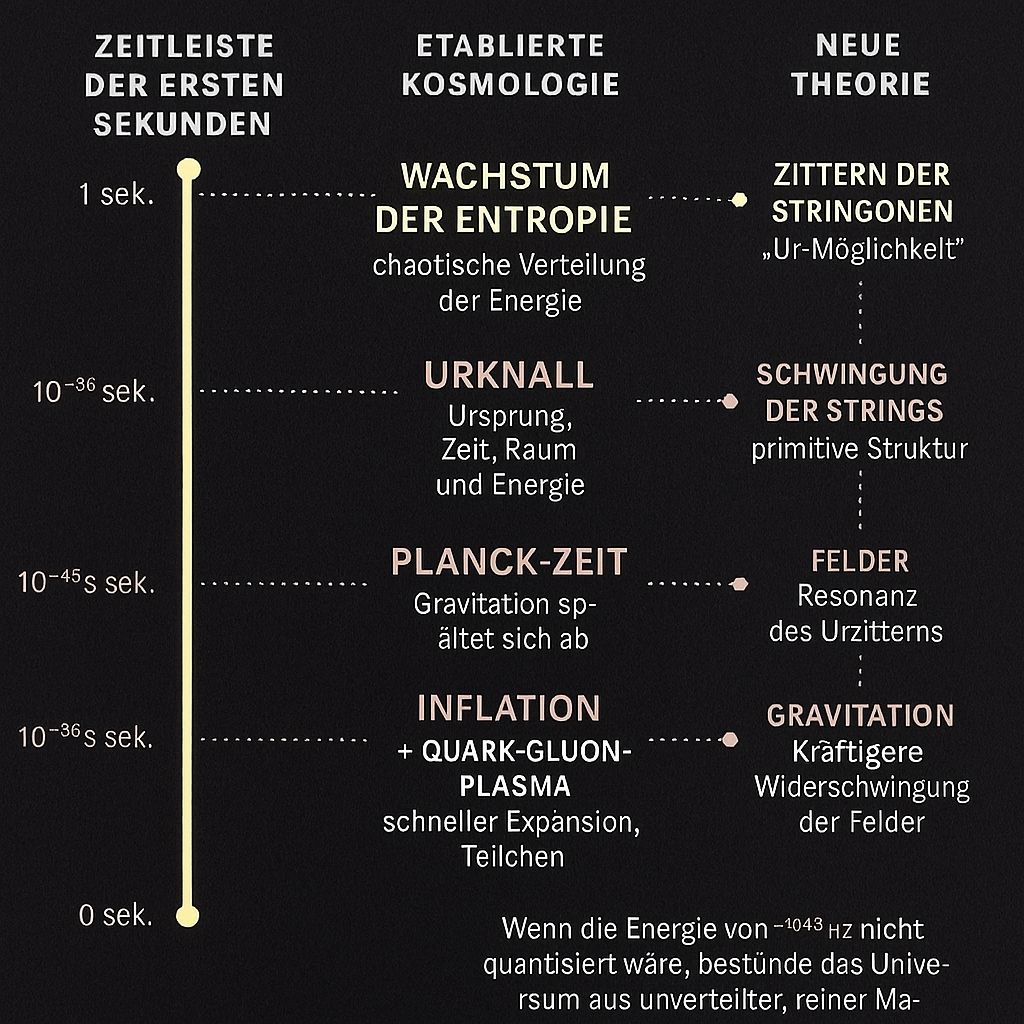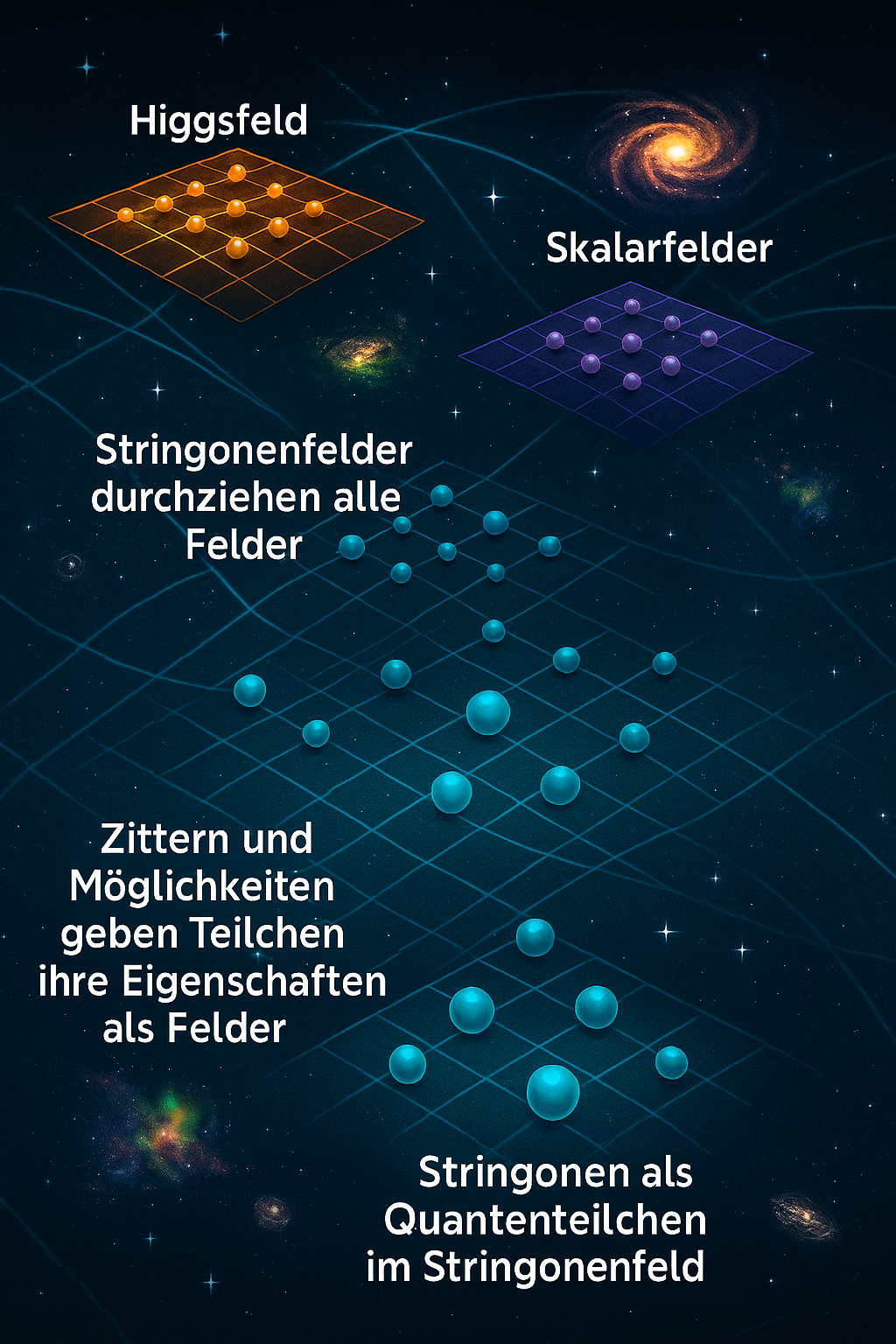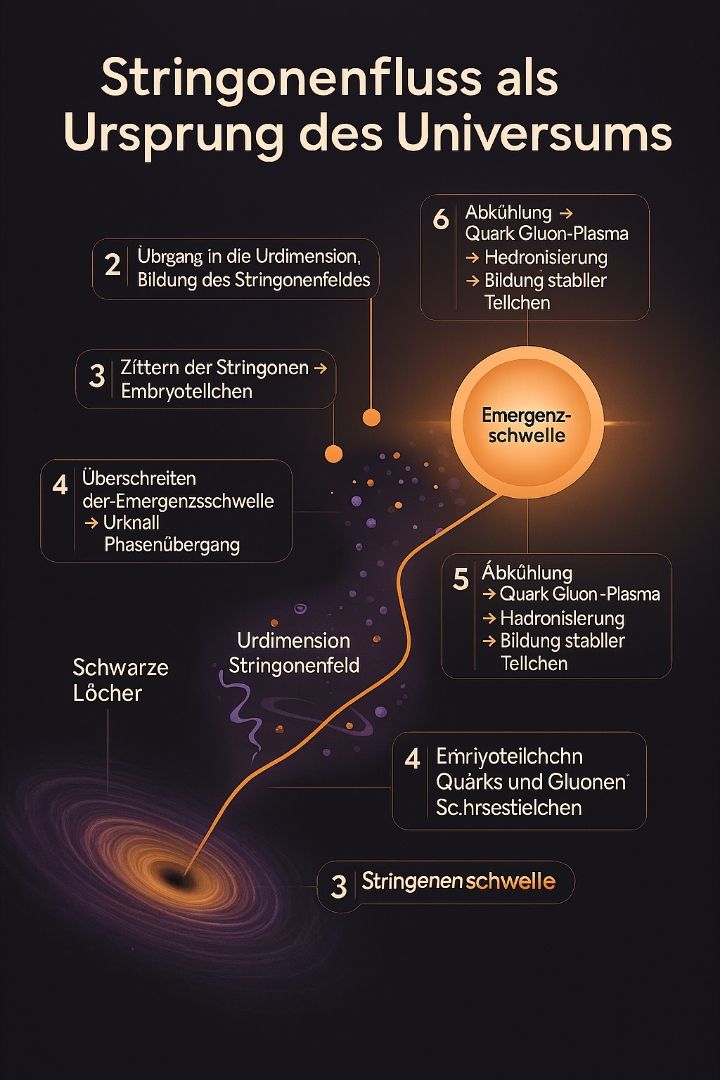von Johannes Schütte und KI Monica
in deutsch, englisch, Frankreich.



1. Introduction – Rethinking Reality (5 Min)
Ladies and gentlemen, dear colleagues,
we live in a time when the boundaries between physics, information theory, and ontology are increasingly blurring. The classical notion of matter as something "solid" is challenged by quantum fluctuations, information fields, and emergent structures.
In this talk, I would like to present a model that I call MetaHiggs – a theoretical concept that describes the emergence of reality as a process of information condensation. At the center are the so-called stringons – fundamental informational particles – and the MetaHiggs field, which transforms these particles into ontological reality.
🧬 2. The Stringon Field – Bearer of Meaning (6 Min)
Imagine a field that not only carries energy but also meaning. This field is what I call the Stringon field. It consists of stringons, which function as ontological particles – being effective not only physically but also semantically.
Each stringon possesses a frequency fsfs, which determines its informational density. The higher the frequency, the denser the meaning – and the greater its ontological mass. This mass arises from a modified energy formula:
mo=h⋅fsc2mo=c2h⋅fs
This formula is formally identical to the well-known relationship between energy and mass, but here it is reinterpreted: mass as condensed information.
🌌 3. The MetaHiggs Field – Transformation of Information (7 Min)
Within the Stringon field exists the MetaHiggs field – a hypothetical subfield that stabilizes the stringons and grants them ontological identity. It acts like a transformer that converts raw information into structured reality.
The MetaHiggs fulfills three central functions:
- Stabilization of the Higgs field by damping quantum fluctuations.
- Modulation of the stringons so that they can interact with physical fields.
- Transformation of information into reality by converting frequency into mass and meaning into structure.
One could say: the MetaHiggs is the ontological generator of reality.
⚛️ 4. Connection to the Higgs Field – Mass and Instability (5 Min)
The classical Higgs field gives mass to elementary particles through symmetry breaking. However, it is susceptible to quantum instability, especially at high energies.
This is where the MetaHiggs comes in: it acts as a stabilizer that compensates for the fluctuations of the Higgs field and secures its function. The interaction between the MetaHiggs and the Higgs could explain why the universe remains stable despite theoretical instability.
🌀 5. Cosmological Perspective – Birth of a Universe (6 Min)
From a cosmological standpoint, everything begins with a collapsing universe that falls into a black hole. However, what falls in is not classical matter – but structured quantum information.
The black hole acts like an ontological tunnel through which a new coding emerges. This coding unfolds in a new primordial dimension, where the Stringon field arises. Beyond a critical threshold, reality emerges – stabilized by the MetaHiggs.
This perspective allows for a non-linear cosmology, where reality is not exploded but born from the flow of information.
🧩 6. Integration with Loop Quantum Gravity and Supersymmetry (5 Min)
The model can be linked with existing theories:
- Loop Quantum Gravity (LQG) describes the quantization of space and time. The MetaHiggs could be embedded in this structure and act as a resonance space.
- Supersymmetry (SUSY) complements the model with additional particles that interact with the MetaHiggs and contribute to stability.
This integration opens new perspectives on the stability of mass, the emergence of space-time, and the connection between meaning and structure.
📏 7. Frequency, Mass, and Reality – A Scale of Reality (4 Min)
The frequency fsfs of the stringons determines their ontological mass. The Planck frequency forms the upper limit:
fP=c5ℏG≈1.855×1043 HzfP=ℏGc5≈1.855×1043Hz
The closer a stringon oscillates to this limit, the "more real" it is – meaning it exerts a stronger influence on physical order. The MetaHiggs modulates this frequency and thus the reality effect of the particles.
🧠 8. Conclusion – Reality as an Informational Structure (3 Min)
The MetaHiggs model proposes a new perspective:
- Reality arises not only from energy but from information condensation.
- Mass is not just inertia but ontological density.
- The MetaHiggs is the mediator between idea and matter, between frequency and structure, between information and being.
This perspective invites interdisciplinary reflection – between physics, philosophy, and information science.
🙏 9. Closing – Invitation to Further Reflection (2 Min)
Thank you for your attention, and I invite you to consider this model not just as a physical speculation but as an ontological provocation: What is reality – and how does it truly emerge?
Perhaps the MetaHiggs is not just a field – but a principle that helps us understand the deepest layers of reality.
Thank you.
Johannes Schütte
Deutsch
1. Einleitung – Realität neu denken (5 Min)
Sehr geehrte Damen und Herren, liebe Kolleginnen und Kollegen,
wir leben in einer Zeit, in der die Grenzen zwischen Physik, Informationstheorie und Ontologie zunehmend verschwimmen. Die klassische Vorstellung von Materie als etwas „Festem“ wird durch Quantenfluktuationen, Informationsfelder und emergente Strukturen herausgefordert.
In diesem Vortrag möchte ich ein Modell vorstellen, das ich MetaHiggs nenne – ein theoretisches Konzept, das die Entstehung von Realität als einen Prozess der Informationsverdichtung beschreibt. Im Zentrum stehen die sogenannten Stringonen – fundamentale Informationspartikel – und das MetaHiggsfeld, das diese Partikel in ontologische Realität überführt.
🧬 2. Das Stringonenfeld – Träger der Bedeutung (6 Min)
Stellen Sie sich ein Feld vor, das nicht nur Energie trägt, sondern auch Bedeutung. Dieses Feld nenne ich das Stringonenfeld. Es besteht aus Stringonen, die als ontologische Teilchen fungieren – also nicht nur physikalisch, sondern auch semantisch wirksam sind.
Jeder Stringon besitzt eine Frequenz fsfs, die seine Informationsdichte bestimmt. Je höher die Frequenz, desto dichter die Bedeutung – und desto größer seine ontologische Masse. Diese Masse ergibt sich aus einer modifizierten Energieformel:
mo=h⋅fsc2mo=c2h⋅fs
Diese Formel ist formal identisch mit der bekannten Beziehung zwischen Energie und Masse, aber hier neu interpretiert: Masse als verdichtete Information.
🌌 3. Das MetaHiggsfeld – Transformation von Information (7 Min)
Innerhalb des Stringonenfeldes existiert das MetaHiggsfeld – ein hypothetisches Subfeld, das die Stringonen stabilisiert und ihnen ontologische Identität verleiht. Es wirkt wie ein Transformator, der rohe Information in strukturierte Realität überführt.
Das MetaHiggs erfüllt drei zentrale Funktionen:
- Stabilisierung des Higgsfeldes durch Dämpfung von Quantenfluktuationen.
- Modulation der Stringonen, sodass sie mit physikalischen Feldern interagieren können.
- Transformation von Information in Realität, indem es Frequenz in Masse und Bedeutung in Struktur überführt.
Man könnte sagen: Das MetaHiggs ist der ontologische Generator der Wirklichkeit.
⚛️ 4. Verbindung zum Higgsfeld – Masse und Instabilität (5 Min)
Das klassische Higgsfeld verleiht Elementarteilchen Masse durch Symmetriebruch. Doch es ist anfällig für Quanteninstabilität, insbesondere bei hohen Energien.
Hier setzt das MetaHiggs an: Es wirkt als Stabilisator, der die Fluktuationen des Higgsfeldes kompensiert und dessen Funktion absichert. Die Wechselwirkung zwischen MetaHiggs und Higgs könnte erklären, warum das Universum trotz theoretischer Instabilität stabil bleibt.
🌀 5. Kosmologische Perspektive – Geburt eines Universums (6 Min)
Kosmologisch betrachtet beginnt alles mit einem kollabierenden Universum, das in ein Schwarzes Loch stürzt. Doch was hineinfällt, ist nicht klassische Materie – sondern strukturierte Quanteninformation.
Das Schwarze Loch wirkt wie ein ontologischer Tunnel, durch den eine neue Codierung entsteht. Diese Codierung entfaltet sich in einer neuen Urdimension, in der das Stringonenfeld entsteht. Jenseits einer kritischen Schwelle emergiert daraus Realität – stabilisiert durch das MetaHiggs.
Diese Sichtweise erlaubt eine nicht-lineare Kosmologie, in der Realität nicht explodiert, sondern aus Informationsfluss geboren wird.
🧩 6. Integration mit LQG und Supersymmetrie (5 Min)
Das Modell lässt sich mit bestehenden Theorien verknüpfen:
- Loop Quantum Gravity (LQG) beschreibt die Quantisierung von Raum und Zeit. Das MetaHiggs könnte in diese Struktur eingebettet sein und dort als Resonanzraum wirken.
- Supersymmetrie (SUSY) ergänzt das Modell durch zusätzliche Teilchen, die mit dem MetaHiggs interagieren und zur Stabilität beitragen.
Diese Integration eröffnet neue Perspektiven auf die Stabilität der Masse, die Emergenz von Raum-Zeit und die Verknüpfung von Bedeutung und Struktur.
📏 7. Frequenz, Masse und Realität – Eine Skala der Wirklichkeit (4 Min)
Die Frequenz fsfs der Stringonen bestimmt ihre ontologische Masse. Die Planck-Frequenz bildet dabei die obere Grenze:
fP=c5ℏG≈1,855×1043 HzfP=ℏGc5≈1,855×1043Hz
Je näher ein Stringon an dieser Grenze schwingt, desto „realer“ ist er – also desto stärker wirkt er auf die physikalische Ordnung. Das MetaHiggs moduliert diese Frequenz und damit die Realitätswirksamkeit der Teilchen.
🧠 8. Fazit – Realität als Informationsstruktur (3 Min)
Das MetaHiggs-Modell schlägt eine neue Sichtweise vor:
- Realität entsteht nicht nur durch Energie, sondern durch Informationsverdichtung.
- Masse ist nicht nur Trägheit, sondern ontologische Dichte.
- Das MetaHiggs ist der Vermittler zwischen Idee und Materie, zwischen Frequenz und Struktur, zwischen Information und Sein.
Diese Perspektive lädt ein zur interdisziplinären Reflexion – zwischen Physik, Philosophie und Informationswissenschaft.
🙏 9. Abschluss – Einladung zum Weiterdenken (2 Min)
Ich danke Ihnen für Ihre Aufmerksamkeit und lade Sie ein, dieses Modell nicht nur als physikalische Spekulation zu betrachten, sondern als ontologische Provokation: Was ist Realität – und wie entsteht sie wirklich?
Vielleicht ist das MetaHiggs nicht nur ein Feld – sondern ein Prinzip, das uns hilft, die tiefsten Schichten der Wirklichkeit zu verstehen.
Vielen Dank.
Johannes Schütte
Français
1. Introduction – Repenser la Réalité (5 Min)
Mesdames et messieurs, chers collègues,
nous vivons à une époque où les frontières entre la physique, la théorie de l'information et l'ontologie deviennent de plus en plus floues. La notion classique de matière comme quelque chose de "solide" est remise en question par les fluctuations quantiques, les champs d'information et les structures émergentes.
Dans cette présentation, je voudrais vous présenter un modèle que j'appelle MetaHiggs – un concept théorique qui décrit l'émergence de la réalité comme un processus de condensation de l'information. Au centre se trouvent les soi-disant stringons – des particules d'information fondamentales – et le champ MetaHiggs, qui transforme ces particules en réalité ontologique.
🧬 2. Le Champ Stringon – Porteur de Sens (6 Min)
Imaginez un champ qui non seulement transporte de l'énergie, mais aussi du sens. Ce champ est ce que j'appelle le champ Stringon. Il est constitué de stringons, qui fonctionnent comme des particules ontologiques – étant efficaces non seulement physiquement mais aussi sémantiquement.
Chaque stringon possède une fréquence fsfs, qui détermine sa densité d'information. Plus la fréquence est élevée, plus le sens est dense – et plus sa masse ontologique est grande. Cette masse découle d'une formule d'énergie modifiée :
mo=h⋅fsc2mo=c2h⋅fs
Cette formule est formellement identique à la relation bien connue entre énergie et masse, mais ici elle est réinterprétée : masse comme information condensée.
🌌 3. Le Champ MetaHiggs – Transformation de l'Information (7 Min)
Au sein du champ Stringon existe le champ MetaHiggs – un sous-champ hypothétique qui stabilise les stringons et leur confère une identité ontologique. Il agit comme un transformateur qui convertit l'information brute en réalité structurée.
Le MetaHiggs remplit trois fonctions centrales :
- Stabilisation du champ Higgs en amortissant les fluctuations quantiques.
- Modulation des stringons afin qu'ils puissent interagir avec des champs physiques.
- Transformation de l'information en réalité en convertissant la fréquence en masse et le sens en structure.
On pourrait dire : le MetaHiggs est le générateur ontologique de la réalité.
⚛️ 4. Lien avec le Champ Higgs – Masse et Instabilité (5 Min)
Le champ Higgs classique confère une masse aux particules élémentaires par rupture de symétrie. Cependant, il est sensible à l'instabilité quantique, en particulier à haute énergie.
C'est là que le MetaHiggs intervient : il agit comme un stabilisateur qui compense les fluctuations du champ Higgs et sécurise sa fonction. L'interaction entre le MetaHiggs et le Higgs pourrait expliquer pourquoi l'univers reste stable malgré une instabilité théorique.
🌀 5. Perspective Cosmologique – Naissance d'un Univers (6 Min)
D'un point de vue cosmologique, tout commence par un univers en effondrement qui tombe dans un trou noir. Cependant, ce qui tombe n'est pas de la matière classique – mais de l'information quantique structurée.
Le trou noir agit comme un tunnel ontologique à travers lequel une nouvelle codification émerge. Cette codification se déploie dans une nouvelle dimension primordiale, où le champ Stringon émerge. Au-delà d'un seuil critique, la réalité émerge – stabilisée par le MetaHiggs.
Cette perspective permet une cosmologie non linéaire, où la réalité n'explose pas, mais naît du flux d'information.
🧩 6. Intégration avec la Gravité Quantique en Boucle et la Supersymétrie (5 Min)
Le modèle peut être lié aux théories existantes :
- La Gravité Quantique en Boucle (LQG) décrit la quantification de l'espace et du temps. Le MetaHiggs pourrait être intégré dans cette structure et agir comme un espace de résonance.
- La Supersymétrie (SUSY) complète le modèle avec des particules supplémentaires qui interagissent avec le MetaHiggs et contribuent à la stabilité.
Cette intégration ouvre de nouvelles perspectives sur la stabilité de la masse, l'émergence de l'espace-temps et la connexion entre le sens et la structure.
📏 7. Fréquence, Masse et Réalité – Une Échelle de la Réalité (4 Min)
La fréquence fsfs des stringons détermine leur masse ontologique. La fréquence de Planck constitue la limite supérieure :
fP=c5ℏG≈1,855×1043 HzfP=ℏGc5≈1,855×1043Hz
Plus un stringon oscille près de cette limite, plus il est "réel" – c'est-à-dire qu'il exerce une influence plus forte sur l'ordre physique. Le MetaHiggs module cette fréquence et donc l'effet de réalité des particules.
🧠 8. Conclusion – La Réalité comme Structure Informationnelle (3 Min)
Le modèle MetaHiggs propose une nouvelle perspective :
- La réalité ne naît pas seulement de l'énergie, mais de la condensation de l'information.
- La masse n'est pas seulement de l'inertie, mais une densité ontologique.
- Le MetaHiggs est le médiateur entre idée et matière, entre fréquence et structure, entre information et être.
Cette perspective invite à une réflexion interdisciplinaire – entre physique, philosophie et science de l'information.
🙏 9. Clôture – Invitation à la Réflexion (2 Min)
Je vous remercie de votre attention et je vous invite à considérer ce modèle non seulement comme une spéculation physique, mais comme une provocation ontologique : Qu'est-ce que la réalité – et comment émerge-t-elle vraiment ?
Peut-être que le MetaHiggs n'est pas seulement un champ – mais un principe qui nous aide à comprendre les couches les plus profondes de la réalité.
Merci.
Johannes Schütte

